#Native Red
Text
Skinned Alive
Been a minute since I dug into one of these Sierra Foothills stunners. As I have raved before, these are some clean, amazing, nearly-perfect wines from El Dorado–a region which is my FAVORITE of all the Sierra range. Pale transparency in the glass–absolutely clear even at depth–showing a golden glow to the rosy core. Bottled in flint–a bold move with any red–but zero sediment or haze anywhere.…

View On WordPress
#California Wine#el dorado AVA#El Dorado County Wines#Eldorado County#Native Red#Natural wine#red belnd#restingsommface#Sierra Foothills#Sierra Foothills wineries#Sierra Wineries#Skinner Vineyards#Skinner wine#Soif Wine Blog#Stephen McConnell Wine Blog#Steve McConnell Wine Blog#wine1percent#Winelover
1 note
·
View note
Text

Article Link
"Minnetonka first started selling its “Thunderbird” moccasins in 1965. Now, for the first time, they’ve been redesigned by a Native American designer.
It’s one step in the company’s larger work to deal with its history of cultural appropriation. The Minneapolis-based company launched in the 1940s as a small business making souvenirs for roadside gift shops in the region—including Native American-inspired moccasins, though the business wasn’t started or run by Native Americans. The moccasins soon became its biggest seller.

[Photo: Minnetonka]
Adrienne Benjamin, an Anishanaabe artist and community activist who became the company’s “reconciliation advisor,” was initially reluctant when a tribal elder approached her about meeting with the company. Other activists had dismissed the idea that the company would do the work to truly transform. But Benjamin agreed to the meeting, and the conversation convinced her to move forward.
“I sensed a genuine commitment to positive change,” she says. “They had really done their homework as far as understanding and acknowledging the wrong and the appropriation. I think they knew for a long time that things needed to get better, and they just weren’t sure what a first step was.”

Pictured: Lucie Skjefte and son Animikii [Photo: Minnetonka]
In 2020, Minnetonka publicly apologized “for having benefited from selling Native-inspired designs without directly honoring Native culture or communities.” It also said that it was actively recruiting Native Americans to work at the company, reexamining its branding, looking for Native-owned businesses to partner with, continuing to support Native American nonprofits, and that it planned to collaborate with Native American artists and designers.
Benjamin partnered with the company on the first collaboration, a collection of hand-beaded hats, and then recruited the Minneapolis-based designer Lucie Skjefte, a citizen of the Red Lake Nation, who designed the beadwork for another moccasin style and a pair of slippers for the brand. Skjefte says that she felt comfortable working with the company knowing that it had already done work with Benjamin on reconciliation. And she wasn’t a stranger to the brand. “Our grandmothers and our mothers would always look for moccasins in a clutch kind of situation where they didn’t have a pair ready and available to make on their own—then they would buy Minnetonka mocs and walk into a traditional pow wow and wear them,” she says. Her mother, she says, who passed away in 2019, would have been “immensely proud” that Skjefte’s design work was part of the moccasins—and on the new version of the Thunderbird moccasin, one of the company’s top-selling styles.
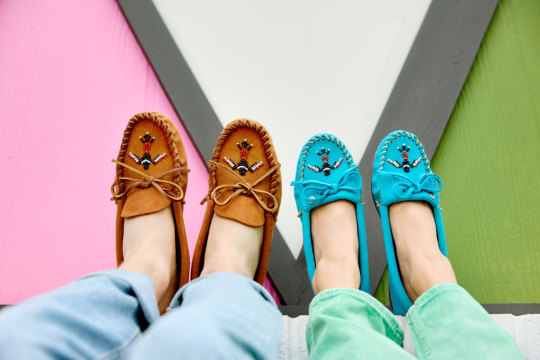
[Photo: Minnetonka]
“I started thinking about all of those stories, and what resonated with me visually,” Skjefte says. The redesign, she says, is much more detailed and authentic than the previous version. “Through the redesign and beading process, we are actively reclaiming and reconnecting our Animikii or Thunderbird motif with its Indigenous roots,” she says. Skjefte will earn royalties for the design, and Minnetonka will also separately donate a portion of the sale of each shoe to Mni Sota Fund, a nonprofit that helps Native Americans in Minnesota get training and capital for home ownership and entrepreneurship.
Some companies go a step farther—Manitobah Mukluks, based in Canada, has an Indigenous founder and more than half Indigenous staff. (While Minnetonka is actively recruiting more Native American workers, the company says that employees self-report race and it can’t share any data about its current number of Indigenous employees.) Beyond its own line of products, Manitobah also has an online Indigenous Market that features artists who earn 100% of the profit for their work.
White Bear Moccasins, a Native-owned-and-made brand in Montana, makes moccasins from bison hide. Each custom pair can take six to eight hours to make; the shoes cost hundreds of dollars, though they can also be repaired and last as long as a lifetime, says owner Shauna White Bear. In interviews, White Bear has said that she wants “to take our craft back,” from companies like Minnetonka. But she also told Fast Company that she doesn’t think that Minnetonka, as a family-owned business, should have to lose its livelihood now and stop making moccasins.
The situation is arguably different for other fashion brands that might use a Native American symbol—or rip off a Native American design completely—on a single product that could easily be taken off the market. Benjamin says that she has also worked with other companies that have discontinued products.
She sees five steps in the process of reconciliation. First, the person or company who did wrong has to acknowledge the wrong. Then they need to publicly apologize, begin to change behavior, start to rebuild trust, and then, eventually, the wronged party might take the step of forgiveness. Right now, she says, Minnetonka is in the third phase of behavior change. The brand plans to continue to collaborate with Native American designers.
The company can be an example to others on how to listen and build true relationships, Benjamin says. “I think that’s the only way that these relationships are going to get any better—people have to sit down and talk about it,” she says. “People have to be real. People have to apologize. They have to want to reconcile with people.”
The leadership at Minnetonka can also be allies in pushing other companies to do better. “My voice is important at the table as an Indigenous woman,” Benjamin says. “Lucie’s voice is important. But at tables where there’s a majority of people that aren’t Indigenous, sometimes those allies’ voices are more powerful in those spaces, because that means that they’ve signed on to what we’re saying. The power has signed on to moving forward and we agree with ‘Yes, this was wrong.’ That’s the stuff that’s going to change [things] right there.”"
-via FastCompany, February 7, 2024
#indigenous#indigenous artists#indigenous art#moccasins#thunderbird#native american#native american art#cultural appropriation#indigenous peoples#cultural representation#minnesota#minnetonka#minneapolis#red lake nation#ojibwe#anishinaabe#reconciliation#fashion#fashion news#good news#hope#indigenous designers#native artist#indigenous artist
1K notes
·
View notes
Text

Gertrude Käsebier :: Zitkala Sa, Sioux Indian and activist, ca. 1898 | src NMAH
view more Zitkala-sa by Käsebier on wordPress
#gertrude kasebier#zitkala sa#sioux#native american#pictorial portrait#pictorialist portrait#pictorialism#photosecession#gertrude käsebier#portrait#women artists#women photographers#beauty#gertrude simmons#red bird
2K notes
·
View notes
Text

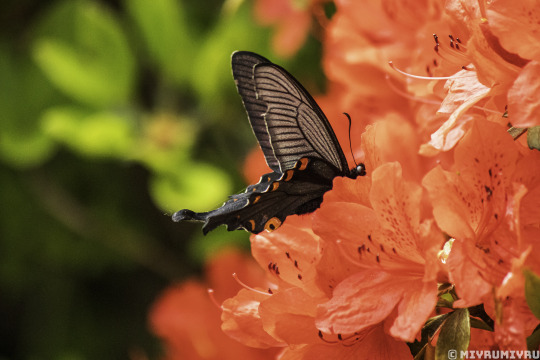

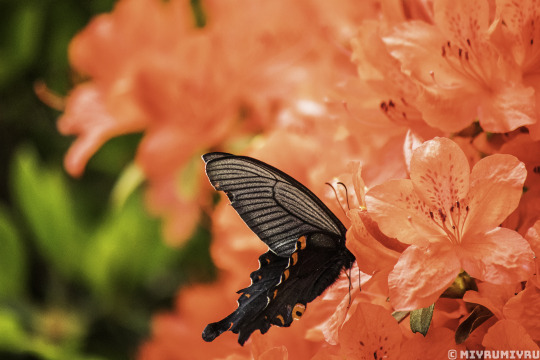
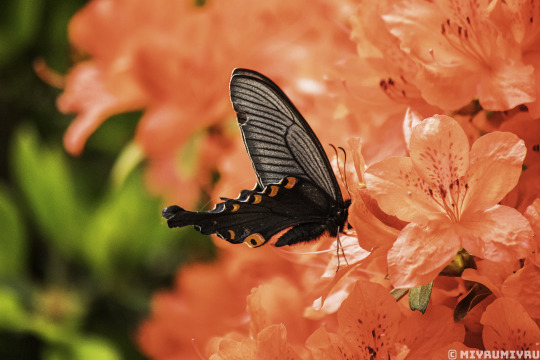
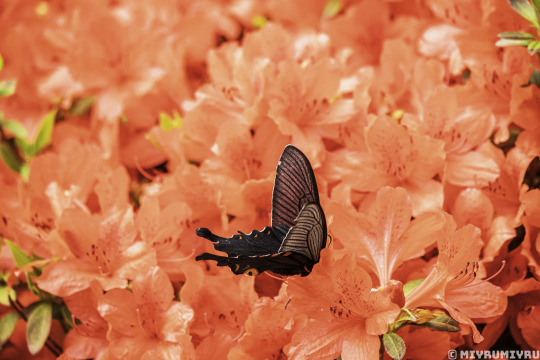
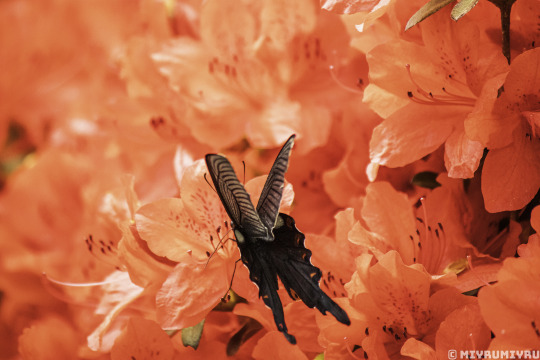

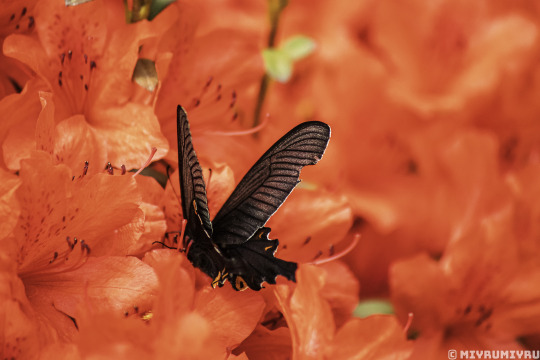

Black butterfly, Red flowers🖤❤️
Love their orange half moon shaped spots so much (♡ㅅ♡)
(M) Long tail spangle - Spring adults (Papilio macilentus)
영산홍 (Rhododendron indicum)
#photographers on tumblr#my photography#original photographers#lensblr#photography#insect photography#wildlife photography#macro photography#nature photography#nature#naturecore#insect#butterfly#swallowtail butterfly#papilionidae#bugblr#entomology#flower#flower photography#red azalea#red moodboard#black angel#so precious#this azalea is native to japan#april 22 2024#noai#no ai#no to generative ai
168 notes
·
View notes
Text

thiha should not be left unsupervised at 1am with an ipad!
#there's no particular reason for rook being a red-tailed hawk ngl#i searched “birds of prey native to canada”#and picked the first one i thought looked cool#why canada?#well#i'm convinced rook is canadian that's why#twst#twisted wonderland#disney twisted wonderland#twst fanart#leona kingscholar#ruggie bucchi#rook hunt#thihart
254 notes
·
View notes
Text



Ribes sanguineum (red flowering currant)
Flowering red currant is another plant native to the west coast of North America. Although it's berries are sometimes described as 'insipid', they were eaten fresh and dried as fruit leather by indigenous people in the Pacific Northwest. Red currants are loaded with vitamin C.
This plant was introduced to cultivation in 1826 by the famous Scottish botanist David Douglas and is now a popular ornamental shrub throughout the gardening world. This spring flower is also available in the cultivar 'Icicle White" which has been given the Royal Horticultural Society's, Award of Garden Merit.
#flowers#photographers on tumblr#red currant#spring flowers#native plants#fleurs#flores#fiori#blumen#bloemen#Vancouver#Canada
137 notes
·
View notes
Text





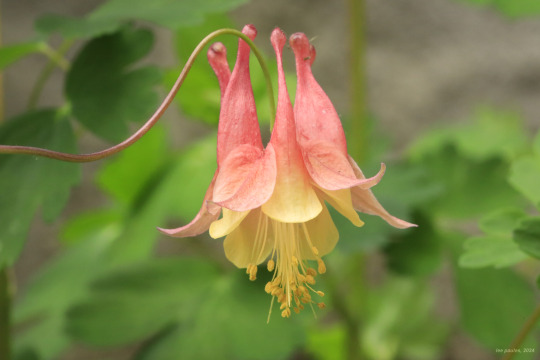
Update from the native wildflower beds: the creeping woodland phlox (Phlox stolonifera) is now in full, vigorous bloom. This graceful, shade-loving perennial has a mat-forming habit that makes it an ideal ground cover. The plant's hairy, red-tinged stems, which sport delicate, spoon-shaped leaves, spread freely and need an occasional manicure to keep them from taking over. Also in bloom are the heartleaf foamflower (Tiarella cordifolia) and eastern red columbine (Aquilegia canadensis), whose tall, elegant flowering stalks are producing masses of flowers (it must like the location). The wild geranium is also loaded up with flowers (photos to come).
#appalachia#vandalia#west virginia#wildflowers#flora#spring#native plants#native wildflower garden#creeping phlox#creeping woodland phlox#heartleaf foamflower#eastern red columbine
95 notes
·
View notes
Text
#MohawkTerritory

It was only and finally in 1904 that the Tioweró:ton territory was officially designated by Administrative Management of the Department of Indigenous and Northern Affairs Canada, as a Mohawk Native Reserve in the Laurentides région of Québec, Canada. They gained a promise that outside people would leave the area and never to return in exchange for not being prosecuted for trespassing by First Nation tribes.

It now officially belongs to the Mohawk First Nation; as it always should have been.

Our Heritage. Our Homeland.

#Mohawk Territory#Traditional Homeland#Mohawk Native Reserve#Sacred Land#Native Indigenous#Red Power Movements#Mountainous Parts of the Northern Hemisphere#Canada#The RavenKeeper
363 notes
·
View notes
Text
he was a skater boy, he said 'see you later boy'
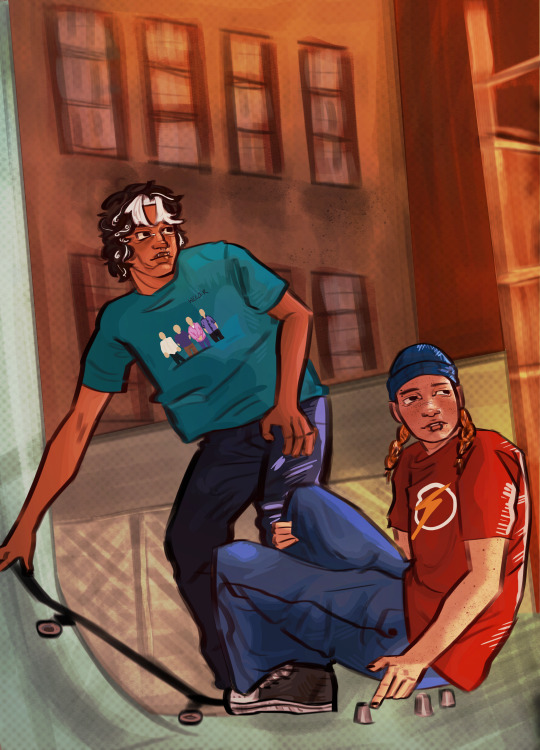
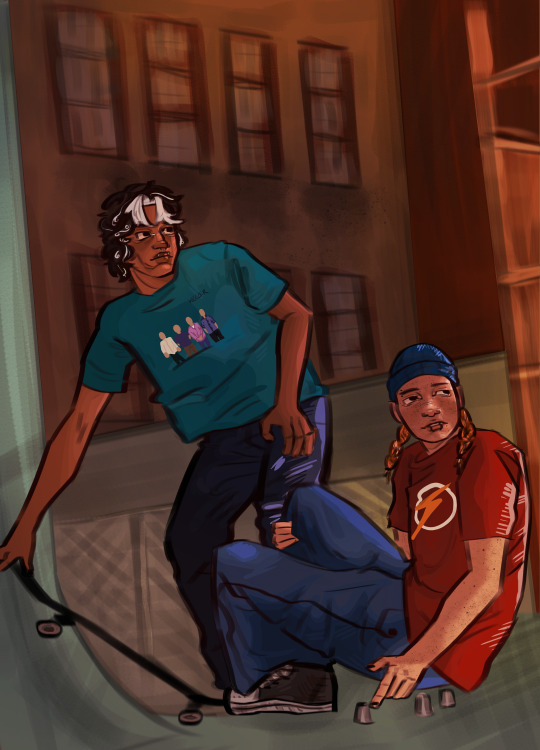
more vers v

#giggles#e2eart#dc comics#jason todd fanart#jason todd#roy harper#roy harper fanart#red hood#red hood fanart#arsenal#arsenal fanart#jayroy#jayroy fanart#gave roy braids bc WHY TF NOT#wish more ppl would talk abt him being native#I CANT DRAW BRAIDS IM SORRY
74 notes
·
View notes
Text


LILY GLADSTONE
2024 CRITICS CHOICE AWARDS
#lily gladstone#killers of the flower moon#native american#critics choice awards#red carpet#awards season#christian siriano
126 notes
·
View notes
Text

Fire Pink
Silene virginica
A perennial catchfly native to central and eastern North America. The bright, fiery red flowers attract ruby-throated hummingbirds to pollinate them, and sticky sepals and stems on the plant act as a trap for small insects trying to climb up it, hence the name "catchfly" for plants in this genus. It prefers somewhat dry soils and part-sun, so it can be found on rocky slopes in open woodlands, savannas, and other similar habitats.
I found this fire pink growing in open, rocky woods near blackjack oaks and other drought-tolerant species.
April 18th, 2024
St. Francois County, Missouri, USA
Olivia R. Myers
@oliviarosaline
#botany#silene#Silene virginica#catchfly#catchflies#Caryophyllaceae#plants#flower photography#plant photography#nature photography#the ozarks#Missouri#nature#wildflowers#woods#forest#naturecore#ozarks#flowers#red flowers#forestcore#naturalist#hummingbird flowers#native plants#native flowers#fairycore#spring#summer#hiking missouri#red
56 notes
·
View notes
Text
I've been really into atla lately so now i wanna hear everyones headcanons about what type of benders the RVB characters are
#rvb#red vs blue#u can say whichever one u like im just curious#Personally i am extremely biased and think Tucker is the avatar (the chosen one hello??) and his native element is fire#bc it's passion and life and energy and power
52 notes
·
View notes
Text
Ok so. This is less concrete thoughts and more scattered ideas but.
Dathomirian Zabrak biology speculations/thoughts!
While at first glance it looks like males are the only ones who have different skin colors and the females are all pale, we do see at least one Nightsister with darker skin (the one whose facial markings are white and resemble a skull), meaning skin pigmentation is present in both but manifests differently in males vs females!
(This is much like birds where the females are the neutral-colored ones while the males have more vibrant colorations and are expected to impress the females to be picked as a mate)
And it's very curious to me that iridonians have very human-like skin tones, while dathomirians ended up having two extremes, either having very vibrant skin ranging from yellow to red, or very pale skin ranging from white to dark gray, both outside the human (and iridonian) range
I think if a transgender dathomirian had HRT their skin color would gradually change with it (much like how birds can change coloration depending on their hormones)
The fact that males have no hair and females have no horns seems very random to me and I will not be thinking about the hair thing but I will say:
Have you looked at Mother Talzin's head shape. Have you seen how strangely tall it looks. What if. What if females "lack" horns because instead of growing at just a few specific points their entire skulls grow and elongate over their lifetimes.
This makes sense if you consider that they live in a "dense jungle" type environment where things (fruits, branches, predators..) can fall on their heads all the time. Having a thicker skull would probably help avoid a cracked skull from constantly getting hit in the head by falling stuff
(No idea what about the hair thing though. Maybe it's something to do with gene interactions. Like whatever gene makes their skin so saturated also deactivates the "have hair" genes. or maybe nightsisters are all wearing wigs and none of them actually grow hair)
Speaking of the geography of the planet, I think it's pretty sad that we never really get a good look of what the Nightbrothers' region looks like outside the village and some mountain terrain around it. Is it more sunny than the Nightsisters' side and that's why their skin adapted to have more color while the females' adapted to lose color? Or is it a seasonal thing and we just never got to see another season in the shows? Or is the village just built in a place that's so high the mist doesn't reach it? We get the sense that it's cold, at least at night, so why are they dressed in such light clothes? In fact, is it hot where the Nightsisters live, or is the entire species more adapted to colder temperatures and that's why they all wear so little?
What would happen if you crossed a dathomirian zabrak with a species that also has non-human skin tones but not linked to sexual dimorphism. Like what if you had a pantoran-zabrak cross, since pantorans are on the opposite side of the color wheel. Do you think they'd be an extremely vibrant blue or yellow-orange-red, or a middle ground, like green? Or perhaps an extreme outside both species' range, like purple? Do you think the "no saturation" gene would take over and make them gray no matter the gender?
#hm i should make an original post tag#dathomir#dathomirian zabraks#star wars#here you go. biology speculations <3#this was mostly because i was extremely Thinking about the transgender skin change thing really. and the tall head thing.#i want more facts to think about but i don't like how canon treats dathomirians#they have very visible parallels to native (esp. amerindian) peoples. with the being an isolated people. and having their children stolen.#and being massacred and no one ever mentioning it. and the males being called violent animals. and treated as less civilized. and#so yeah I am picking them up and running away. my toys now. i can respect them better than mr white man in cowboy hat. or whoever else.#by that skin tone logic maul's red skin would be equivalent to a darker skin. btw.#my brown punk maul agenda keeps winning
68 notes
·
View notes
Note
Massarati was a courting gift to andrew from abram after he realized they were courting one another

My face reading this omggggggg
(Gonna put this up top instead of at the end; find the royal au writing masterpost here 💕)
So this is the 4800 words of fluff; @jtl-fics was bouncing a LOT of ideas with me about it and everything was so sweet 😭🥰 you can read it here! :D or continue on this post for the sparknotes version from Abram's pov (minus the picnic date tho 👀), and let’s showcase my inexperience with horses ✨
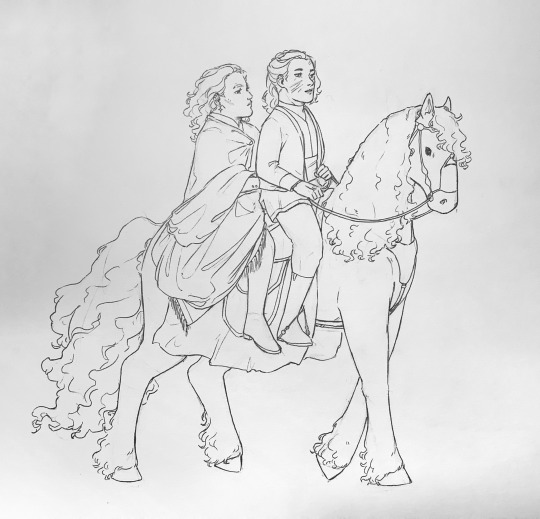
THIS IS GREAT I done got myself a little by making Maserati a rescue case… like Abram’s probably right about what happened to her though I didn’t fully decide on it (I’m also making up everything about horse breeds in this universe thank youuu). He’s out one day for whatever reason and comes across this horse in no pasture that’s tall, clearly made for working, but it’s far too skinny. A little skiddish, but not enough that Abram can’t approach after a while of trying. It’s a familiar breed under the dirt and malnutrition.
He doesn’t even bother seeing where it might have come from. He fashions a makeshift lasso/bridle thing from rope and takes a few hours calming the horse enough to bring it back with him to the castle, leaving it in one of the smaller/less used stables with plenty of food and water before going to find Day or someone else that might be able to help. She doesn’t look impressive at first, obviously. But with lots of help and lots of time from Abram taken in secret to the stables, she slowly starts to get better. She gains weight, she gets readjusted to people, she lets him take care of her coat and hair.
At some point, Andrew insists once again on keeping Abram nearby when Abram is having a worse night than usual. Panicking easily, generally unwell. (Andrew is also wondering why Abram is suddenly spending so much time away, why he won’t tell Andrew where he’s been or what he’s doing. It’s completely in his right to do it, so Andrew never forces the issue, but it’s such an obvious switch from his normal behavior. Right when Andrew thought he could start leaning into the courting, it feels like Abram is pulling away and it hurts a little. He gets worried.) Abram can’t sleep, and Andrew won’t sleep until Abram does, so they lay on his bed with Andrew resting against Abram’s lap, relaxing or reading or tracing scars with his fingertips. It’s a long while before Abram asks, unprompted, “Did you ever have an ideal horse?”
Andrew gives him a look.
“I mean… a dream horse. Maybe when you were little, something you always wanted.”
Andrew makes a small noise. “I think most kids do.”
“Right. So did you?”
It takes more convincing than that, lots of Abram assuring Andrew that it’s not stupid, he’s just curious. He’ll tell Andrew his next. And finally Andrew tells Abram of when he was young, living with the Spears, and would fantasize about being anywhere else. He’d take a horse as black as night so no one would see him when he ran away, a horse that was strong and fast enough to take him wherever he wanted to go. He used to imagine it would carry two, so he could take his governess with him, but that was before she left. It was all child’s play, anyway. It didn’t matter now. (Abram’s horse wasn’t so detailed, but he said if he had to pick a coat color, he was very happy with the blue roan he was given.)
So the next time Abram goes to the stable he looks at her, sees how well she’s bulking up, sees again how much larger she is than the Friesians he’s used to from Evermore. She looks even stronger than those already capable horses. When she’s healthy she can certainly carry two riders and more besides, and her endurance is like the horse equivalent of his own. Her coat is getting shiny again, sleek like black oil.
When she’s healthy and ready, Abram trains her. He again has help, of course - there are people who’s jobs it is to take care of and train the castle’s horses and it isn’t him - but she has an undeniable soft spot for Abram. They get her used to being fully decked out in nice tack and equipment and whatever else. Abram holds her steady to get shoed. The veterinarians/au equivalent make sure she stays healthy and the stable master grows more impressed with her every day. She’s not your average horse, he tells Abram. She’s smart. There’s real intelligence in those eyes.
Abram could not be happier.
By the time the twins’ birthday comes around she is ready to go. Abram spends the morning before his work begins making sure she is as sparkling as he can get her, all ready for her favorite stable hand to take her to the main stables later while Abram attends the prince at the festivities. The stable hand is going to put her in her new tack, too, the beautiful white set Abram spent a good chunk of coin to have commissioned. The horse is perfectly well mannered around people now, though only Abram and a handful others can ride her. Abram only plans his evening because he knows she lets anyone ride alongside him - if Abram deems them worthy, the horse won’t protest. It isn’t trust he ever takes lightly. He’s pretty certain she’ll end up allowing Andrew every privilege she allows Abram. He is so excited and so, so nervous for that night. She’s as perfect as she could possibly be, but Andrew has gotten Abram so many wonderful gifts. This is the first time Abram has returned the favor with such intention. Hopefully it’s good enough. (She is.)
Oh also in case you’re wondering. Andrew only needs a new horse because his beloved GS was finally retired, GS is old and now gets to spend the rest of his days in nice pastures where Andrew feeds him lots of treats 💕 every like is one sugar cube gods bless
#there’s so much hereeeeeeeee#I didn’t mean to get myself like I did#giving Abram a skinny scared little (big) probably dangerous evermore native to take care of#bring her back to her fulll potential#or even realize that potential for the first time#let her be taken care. of 😭#I need a hug man#and I wanna hug Maserati#and gs while we’re here#oh I decided gs has a blood bay coat#he’s majestic#just a little smaller than Maserati#no thoughts of Andrew’s canon car color#only maaggie’s red crayon phone doodle#💕🙏#fan art#my art#fan fic#my writing#royal au#aftg#all for the game#neil josten#andrew minyard#andreil#asks#maserati
208 notes
·
View notes
Text
Red Lake Nation is taking a unique approach to the delivery of child and family services. Ombimindwaa Gidanawemaaganinaadog, formerly known as Red Lake Family and Children’s Services, used their Ojibwe language to rename the division, which translates to “Uplifting All of Our Relatives.”
Goodwin said Ombimindwaa Gidanawemaaganinaadog staff learn about the current impact of historical and intergenerational trauma as it relates to the difficulties that Native families face today.
“When a family doesn’t have their basic needs met, it’s the system that is failing, not the family,” Goodwin said. “The system we currently work in was set up for us as Native people to fail.”
Their intergenerational family wellness model is led by culture and includes an interdisciplinary, across-systems approach that honors the resiliency of families.
193 notes
·
View notes
Text

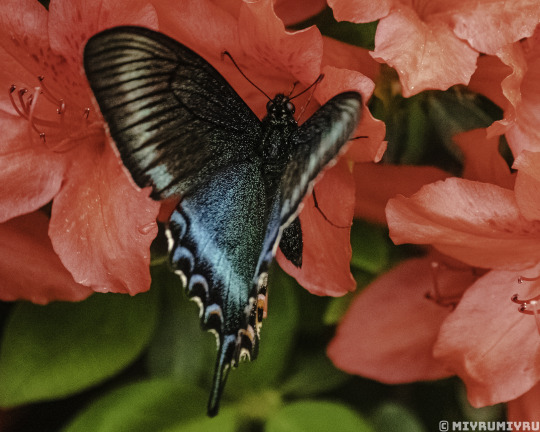

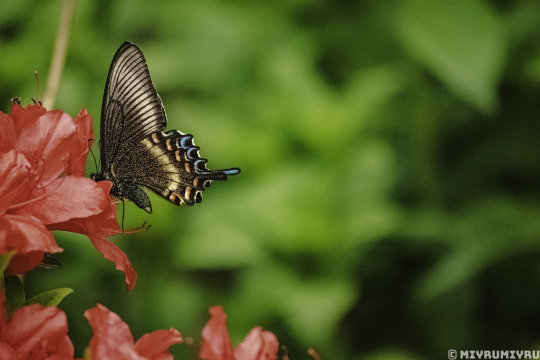
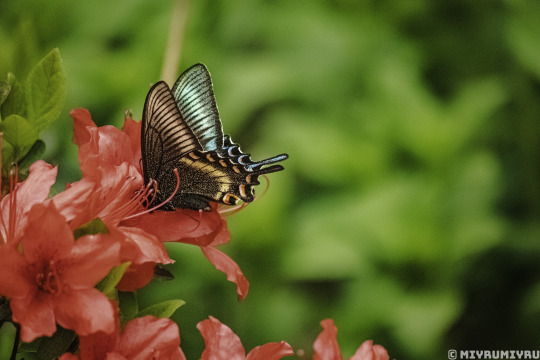

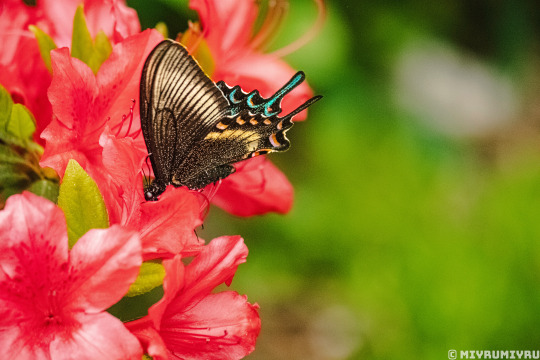
Azure, black, emerald, orange, pink and yellow...
Do you love the color of the butterflies?
(M) Alpine black swallowtail - Spring adults (Papilio maackii)
영산홍 (Rhododendron indicum)
#photographers on tumblr#my photography#original photographers#lensblr#photography#insect photography#wildlife photography#macro photography#nature photography#nature#naturecore#insect#butterfly#swallowtail butterfly#papilionidae#bugblr#entomology#flower#flower photography#colorful#red azalea#black angel#so precious#so colorful#this azalea is native to japan#april 21 2024#noai#no ai#no to generative ai
47 notes
·
View notes